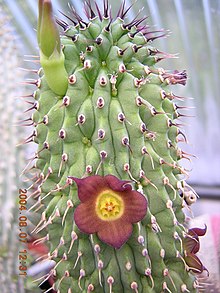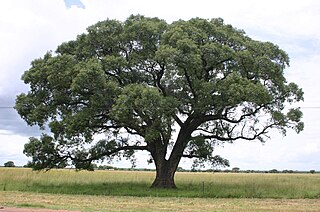
Sclerocarya birrea, commonly known as the marula, is a medium-sized deciduous fruit-bearing tree, indigenous to the miombo woodlands of Southern Africa, the Sudano-Sahelian range of West Africa, the savanna woodlands of East Africa and Madagascar.

Hoodia is a genus of flowering plants in the family Apocynaceae, under the subfamily Asclepiadoideae, native to Southern Africa.

Stapelia is a genus of low-growing, spineless, stem succulent plants, predominantly from South Africa with a few from other parts of Africa. Several Asian and Latin American species were formerly included but they have all now been transferred to other genera. The flowers of certain species, most notably Stapelia gigantea, can reach 41 cm (16 inches) in diameter when fully open. Most Stapelia flowers are visibly hairy and generate the odor of rotten flesh when they bloom.

The Brandberg is Namibia's highest mountain.
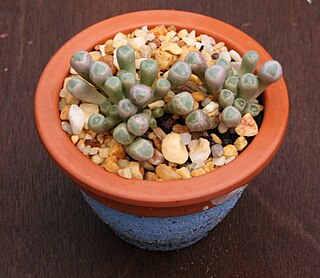
Fenestraria (known as babies' toes is a genus of succulent plants in the family Aizoaceae, native to the Namaqualand in Namibia.

Hoodia gordonii, also known as Bushman’s hat, is a leafless spiny succulent plant supposed to have therapeutic properties in folk medicine. It grows naturally in Botswana, South Africa and Namibia. The species became internationally known and threatened by collectors, after a marketing campaign falsely claimed that it was an appetite suppressant for weight loss. The flowers smell like rotten meat and are pollinated mainly by flies. The indigenous San people of the Namib desert call this plant ǁhoba.

Hoodia juttae is a species of plant in the family Apocynaceae. It is endemic to Namibia. Its natural habitats are rocky areas and cold desert. H. juttae is found around the Little and Great Karas mountains. It is threatened by collection. The plant was discovered by Jutta Dinter, the wife of botanist, Kurt Dinter in 1913. The scientific name refers to Jutta.

Hoodia ruschii is a species of stem succulent plant in the family Apocynaceae. It is endemic to Namibia. Its natural habitats are rocky areas and cold desert.
Hoodia triebneri is a species of plant in the family Apocynaceae. It is endemic to Namibia. Its natural habitat is rocky areas, especially underneath Acacia trees and below ridges.

Felicia filifolia is a Southern African member of the family Asteraceae. It is a hardy, sprawling shrub growing to about 1 metre tall. Leaves are narrow and clustered along the twigs. When blooming it is densely covered in flowerheads with ray florets that are pink-mauve to white and disc florets that are yellow. In the wild, flowers can be found August to December.
Hoodia flava is a succulent native to the Cape Province in South Africa and to Namibia. It has a unique pattern of distribution, growing inside bushes or on gravelly slopes and hills. It is commonly known as ghaap or yellow-flowered ghaap in the Afrikaans language.

Crassula capitella, is a perennial succulent plant native to southern Africa.

Crassula nudicaulis is a succulent plant native to South Africa, and Lesotho.
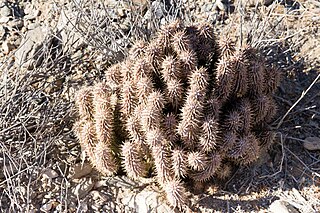
Hoodia alstonii is a succulent plant native to Namibia and the Cape Province of South Africa. H. alstonii is also known commonly as ghaap, an Afrikaans name. It tends to grow in rocky, desert areas.
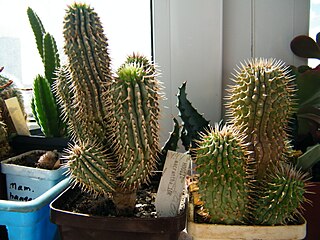
Hoodia macrantha is a succulent plant native to Namibia and the Cape Province of South Africa. It is regarded by some sources as a synonym of the accepted name for the plant, Hoodia currorii subsp. currorii.

Hoodia currorii is a succulent plant native to Namibia and the Cape Province of South Africa. It grows in desert areas and is common along the road from Karibib to Swakopmund in Namibia. It is also known as ghaap in the vernacular.

Crassula brevifolia is a succulent plant native to the arid western edge of South Africa as well as southern Namibia.

Tylecodon paniculatus, also known as butter bush, butter tree, butterboom or rooisuikerblom (Afrikaans), is a species of succulent plant in the genus Tylecodon belonging to the family Crassulaceae.
Rachel P. Wynberg is a South African biodiversity researcher and natural scientist who is a professor at the department of Environmental and Geography Sciences at the University of Cape Town.
